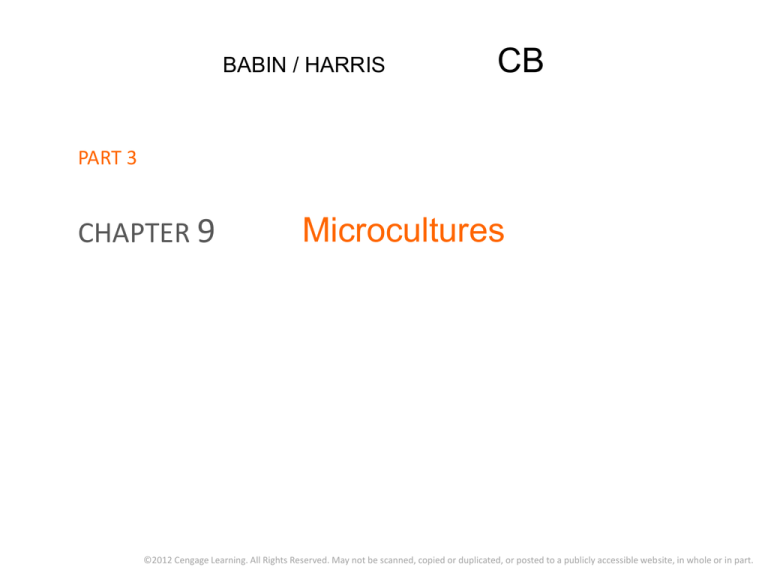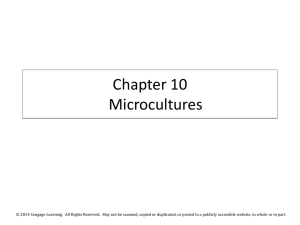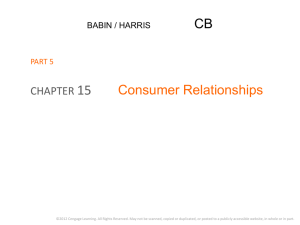
BABIN / HARRIS
CB
PART 3
CHAPTER 9
Microcultures
©2012 Cengage Learning. All Rights Reserved. May not be scanned, copied or duplicated, or posted to a publicly accessible website, in whole or in part.
Learning Outcomes
1. Apply the concept of microculture as it
influences consumer behavior.
2. Know the major U.S. microcultural groups.
3. Realize that microculture is not a uniquely
American phenomenon.
4. Perform a demographic analysis.
5. Identify major cultural and demographic
trends.
9-2
©2012 Cengage Learning. All Rights Reserved. May not be scanned, copied or duplicated, or posted to a publicly accessible website, in whole or in part.
Culture
• Culture is a universal phenomenon.
• Individuals may belong to many cultural
groups at once. These groups may
fluctuate.
LO1
9-3
©2012 Cengage Learning. All Rights Reserved. May not be scanned, copied or duplicated, or posted to a publicly accessible website, in whole or in part.
Microculture
• Culture is hierarchical. Smaller cultural
groups (microcultures) link to one larger
cultural group.
• Microculture—a group of people who share
similar values and tastes that are subsumed
within a larger culture.
LO1
9-4
©2012 Cengage Learning. All Rights Reserved. May not be scanned, copied or duplicated, or posted to a publicly accessible website, in whole or in part.
Microculture Roles and
Expectations
• Each microculture has certain role
expectations for its members.
• Role conflict—a situation where a consumer
experiences conflicting expectations based on
cultural expectations.
• Divergence—a situation in which consumers
choose membership in microcultures in order
to stand out or define themselves.
LO1
9-5
©2012 Cengage Learning. All Rights Reserved. May not be scanned, copied or duplicated, or posted to a publicly accessible website, in whole or in part.
Regional Consumers
• Consumer preferences vary by region.
• In 1981, Garreau identified the nine nation
approach to segmentation.
• One significant area in the U.S. is the
“borderland” region, or the states that
share a border with Mexico.
LO2
9-6
©2012 Cengage Learning. All Rights Reserved. May not be scanned, copied or duplicated, or posted to a publicly accessible website, in whole or in part.
Sex-Roles and Microculture
• Sex roles refer to the societal expectations
for men and women among members of a
cultural group.
• Marketers must be aware of sex-roles
because they are linked to purchasing
behavior.
• Marketing communications are carefully
segmented toward males or females and
their cognitive structuring.
LO2
9-7
©2012 Cengage Learning. All Rights Reserved. May not be scanned, copied or duplicated, or posted to a publicly accessible website, in whole or in part.
Age-Based Microculture
• People of the same age tend to share
similar values and consumer preferences.
• This is especially true in teens and seems
to apply across nations leading to a world
teen culture.
LO2
9-8
©2012 Cengage Learning. All Rights Reserved. May not be scanned, copied or duplicated, or posted to a publicly accessible website, in whole or in part.
Generation Microculture
• Cohort—a group of people who have lived
the same major experiences, which end up
shaping their core values.
•
•
•
•
Greatest Generation
Baby Boomers
Generation X
Millennials
• Marketers pay close attention to generational
effects in order to successfully promote
products to each cohort.
LO2
9-9
©2012 Cengage Learning. All Rights Reserved. May not be scanned, copied or duplicated, or posted to a publicly accessible website, in whole or in part.
Religious Microculture
• Religion affects consumer culture because
religious beliefs, even for the non-devout,
can effect all manner of daily life.
•
•
•
•
•
LO2
Weekend days
Material acquisitions
Food and beverage consumption
Budget allocations
Clothing choices
9-10
©2012 Cengage Learning. All Rights Reserved. May not be scanned, copied or duplicated, or posted to a publicly accessible website, in whole or in part.
Ethnic Microculture
• Hispanic culture
• African American culture
• Asian culture
LO2
9-11
©2012 Cengage Learning. All Rights Reserved. May not be scanned, copied or duplicated, or posted to a publicly accessible website, in whole or in part.
Income and Social Class
Microculture
• Important terms:
•
•
•
•
•
•
LO2
Social class
Habitus
Homogeny
Social stratification
Status symbols
BOP consumers
9-12
©2012 Cengage Learning. All Rights Reserved. May not be scanned, copied or duplicated, or posted to a publicly accessible website, in whole or in part.
Social Class in the U.S.
•
•
•
•
•
•
Upper class
Lower upper class
Upper middle class
Lower middle class
Upper lower class
Lower lower class
LO2
9-13
©2012 Cengage Learning. All Rights Reserved. May not be scanned, copied or duplicated, or posted to a publicly accessible website, in whole or in part.
Street Microcultures
•
•
•
•
•
Sports
Music
Goth
Gaming
Virtual
LO2
9-14
©2012 Cengage Learning. All Rights Reserved. May not be scanned, copied or duplicated, or posted to a publicly accessible website, in whole or in part.
Microcultures Exist Globally
• Other countries and regions have many
microcultures.
• These microcultures might be based on
anything from language to fashion.
• Global marketing efforts must consider
culture and microculture.
LO3
9-15
©2012 Cengage Learning. All Rights Reserved. May not be scanned, copied or duplicated, or posted to a publicly accessible website, in whole or in part.
Demographics
• Demographics—relatively tangible human
characteristics that describe consumers.
• Geodemographics—a study (using tools
such as PRIZM) of people based on the fact
that people with similar demographics
tend to live close to one another.
LO4
9-16
©2012 Cengage Learning. All Rights Reserved. May not be scanned, copied or duplicated, or posted to a publicly accessible website, in whole or in part.
Demographic Analysis
• Demographic analysis—a profile of a
consumer group based on their
demographics.
LO4
9-17
©2012 Cengage Learning. All Rights Reserved. May not be scanned, copied or duplicated, or posted to a publicly accessible website, in whole or in part.
Cultural and Demographic Trends
Affecting Consumer Behavior
•
•
•
•
Declining birth rates
Increasing consumer affluence
Increasing life expectancy
Increasing cultural diversity
LO5
9-18
©2012 Cengage Learning. All Rights Reserved. May not be scanned, copied or duplicated, or posted to a publicly accessible website, in whole or in part.








